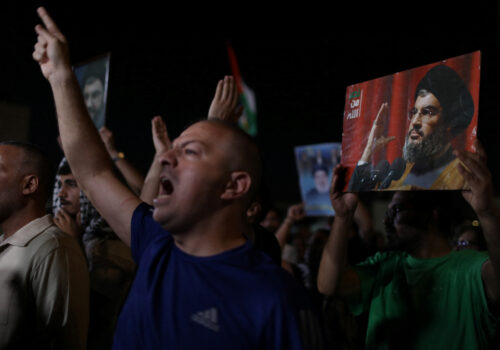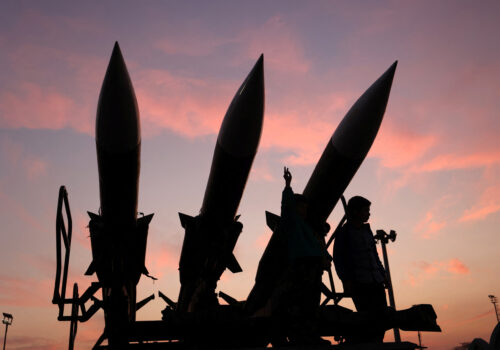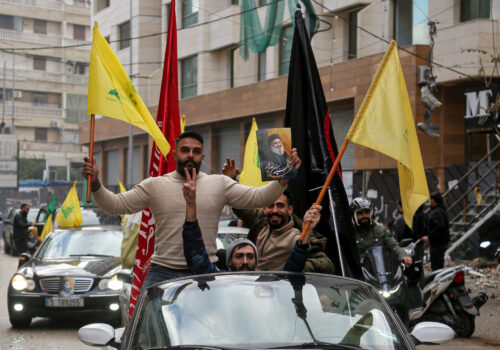What lies ahead for the Israel-Hamas war—and what the United States should do about it
Yahya Sinwar, the former leader of Hamas who was killed in Gaza in October, brought a unique and often confrontational approach to leading the group since he rose to prominence. A former Israeli prisoner and a hardened militant, Sinwar carried a reputation for being ruthless and strategically uncompromising. His leadership saw Hamas pursue an increasingly aggressive stance toward Israel, peaking with the October 7, 2023, terrorist attack in Israel that killed 1,200 people.
While Hamas initially demonstrated sincere interest in a negotiated ceasefire and potential diplomatic resolution to the conflict Israel in the Gaza Strip, the last month has seen it largely withdraw from and refuse to participate in these efforts. In early November, the Qatari government ceased its mediation efforts, citing a lack of good-faith negotiations and stating that the “Hamas political office no longer serves its purpose.” It is likely that Israel’s successful operations to degrade both Lebanese Hezbollah and the Islamic Revolutionary Guard Corps–Quds Force (IRGC-QF) have severely reshaped the strategic calculus of the remaining Hamas senior leadership.
Sinwar’s fatalism was often interpreted as a willingness to accept heavy losses in exchange for long-term ideological goals. He embraced a narrative of martyrdom that resonates with the base of Hamas’s support, with death in conflict against Israel seen as a worthy end. Under Sinwar’s leadership, Hamas has shown little hesitation in confronting Israel even when it appears militarily disadvantageous, highlighting Sinwar’s focus on ideological rather than pragmatic calculations. This approach aligns with the long-standing Hamas principle of resistance (muqawama) but adds an intensity that escalates the risk of broader and more destructive conflicts.
SIGN UP FOR THIS WEEK IN THE MIDEAST NEWSLETTER
However, beyond fatalism, there was a strategic component to Sinwar’s leadership. He had previously overseen periods of tactical ceasefires and negotiations, showing that—despite the group’s extreme rhetoric—he was not opposed to temporary pauses in fighting if it meant regrouping and fortifying Hamas’s position. This pattern has been particularly evident when Hamas faces significant setbacks or needs time to reorganize its military and political structures. This makes Hamas’s current recalcitrance to negotiate for a ceasefire all the more vexing.
It is likely that Hamas’s current approach to negotiations with Israel stems from an acceptance of the IRGC-QF’s clear prioritization of restoring Hezbollah. Recent Israeli military successes against Hezbollah, particularly through targeted strikes and intelligence operations, have severely weakened Hezbollah’s operational capacity and severely undermined Tehran’s regional capabilities.
Hezbollah’s losses have not only reduced its military capabilities but also eliminated a number of senior leaders and key intermediaries between the group and its Iranian patrons. The pressure on Hezbollah to rebuild will limit Iran’s ability to support Hamas in the short term. This shift could also relieve some of the Israeli pressure on Hamas, allowing Hamas a window to reorganize without being drawn into the broader conflict dynamics with Hezbollah and Israel. Sinwar’s death will further undermine any efforts by Iran to bolster Hamas as the IRGC-QF struggles to reestablish effective relations with the replacement leadership.
The IRGC-QF likely finds it easier—and ideologically prefers—to focus on restoring Hezbollah, given the physical proximity of Hezbollah to Iranian bases of operation in Syria and Iraq and its shared Shia religious ideology. As a Sunni-majority group, Hamas has historically enjoyed less support from Iran in comparison Hezbollah and other Shia-dominated groups, leading to Hamas accusing Tehran of “betrayal” last year. By comparison, to reconstitute Hamas in Gaza, the IRGC-QF must smuggle munitions and other supplies along a far more circuitous route through Oman, Yemen, the Red Sea, Sudan, and Egypt.
The situation is complex for Hamas. On one hand, it loses a powerful ally with Hezbollah’s weakened state, particularly one that has provided significant complementary military and logistical support in the past. On the other hand, Israel’s clear shift to focusing on destroying Hezbollah might afford Hamas breathing room to consolidate its resources and reorganize.
With Hamas being further down on Iran’s priority list, the group’s leadership likely sees less advantage in negotiating a ceasefire right now, as Iran would be less likely to send assistance for reconstituting. Iran’s backing, although critical, is not as reliable or consistent as it once was. With Iran’s economic limitations, exacerbated by sanctions and its own need to focus resources on rebuilding Hezbollah, Hamas will likely face reductions in Iranian financial and military support in the near future. In response, Hamas has already shown signs of diversifying its revenue and supply streams, a necessity for sustaining its operations.
One avenue for diversification involves forging new alliances with regional actors that are sympathetic to the Palestinian cause but not directly aligned with Iran. Since 2007, Qatar has provided Hamas nearly $2 billion in financial support, focusing on humanitarian aid that bolsters Gaza’s infrastructure. Turkey has also extended significant diplomatic and fundraising support, though Qatar and Turkey need to balance these actions with broader geopolitical calculations and relationships with other regional powers, including Israel.
Moreover, Hamas could deepen its covert ties with actors in Egypt’s Sinai Peninsula, where smuggling networks provide a critical lifeline for weapons and other supplies. While Egyptian authorities have cracked down on these networks, Hamas has shown a capacity to adapt and work around such challenges. The ongoing civil wars in Egypt’s neighbors Libya and Sudan also help ensure the region is awash in weapons available to the highest bidder, providing another potential source of arms.
Hamas has significantly ramped up its domestic production of rockets and other munitions. Leveraging locally sourced materials, Hamas’s engineers have managed to build a substantial stockpile of crude, but effective, projectiles. This shift toward self-reliance has been a critical factor in sustaining the group’s military capabilities, especially as external support fluctuates. Hamas will likely continue this trend, focusing on upgrading its weapons programs to maintain operational readiness, even in the face of tightened sanctions and supply shortages. What remains to be seen is the impact that Israel’s sustained combat operations against Hamas in Gaza will have on Hamas’s effort to become more self-reliant.
Over several years, Hamas has been increasingly using cryptocurrencies as a means of circumventing international banking restrictions and sanctions (although, as a proportion, cryptocurrency remains small in comparison to other sources of funding). Bitcoin and other digital currencies offer Hamas a relatively anonymous and decentralized means of transferring funds, making it difficult for international authorities to track or block these financial flows. This method of financing has seen increased use in recent years, with reports of Hamas soliciting cryptocurrency donations via online platforms.
In parallel, Hamas is likely to increase its reliance on black-market activities and other forms of illicit financing, such as smuggling and money laundering through front companies and charities in sympathetic states. Hamas has used sham charities to exploit sympathy for Palestinians in the West, raising funds through donation campaigns with pro-Palestinian messages. While these avenues of raising funds come with risks for Hamas, particularly as international counterterrorism financing efforts intensify, they offer alternative revenue streams for Hamas to supplement reduced Iranian support.
Predictive paths for the Israel-Hamas conflict
Given these dynamics, several potential scenarios could unfold in the Israel-Hamas conflict, each shaped by regional shifts, international interventions, and Hamas’s ability to adapt to its changing environment.
One likely scenario is the continuation of the current pattern of sporadic escalations followed by periods of relative calm, punctuated by rocket attacks and retaliatory Israeli strikes. The current Israeli focus on Hezbollah and Iran could create time and space for Hamas to reestablish this pattern. Hamas might opt to engage in periodic confrontations to maintain its image of resistance, without pushing for a full-scale conflict that would strain its resources.
This would allow the group to reconsolidate its position in Gaza and focus on rebuilding its military capabilities while avoiding the kind of overwhelming Israeli response that could decimate its leadership and infrastructure. Despite, or perhaps because of, the devastation Israel has wreaked in Gaza, it is unlikely that Hamas will have significant issues attracting new recruits to its cause.
Alternatively, a full-scale conflict could erupt if internal pressures within Gaza, such as economic collapse or political unrest, push Hamas to escalate as a means of redirecting public anger toward Israel. In such a suicidal assault, Hamas might throw all its remaining combat power into last-ditch offensive operations against Israel using tactics similar to those of its October 7 attack. Additionally, external factors—such as conflict between Israel and Hezbollah—could trigger broader regional instability that draws Hamas into a larger confrontation.
Given Israel’s military superiority, Hamas would likely face significant losses in this scenario. However, echoes of Sinwar’s confrontational approach suggest that Hamas might be willing to accept such losses if it believes that it could emerge with its ideological legitimacy intact, or even enhanced, in the eyes of its supporters. Absent strong commitments from Iran and Hezbollah to support Hamas far better than they have in the current conflict, it is unlikely that Hamas will instigate a full-scale conflict.
A third scenario involves increased international mediation efforts, particularly efforts led by regional powers such as Egypt and Qatar, which have a vested interest in preventing Gaza from descending into chaos. While Qatar recently ceased its own mediation, its long history with Israel and Hamas makes it a preferred interlocutor. This could lead to temporary ceasefires or agreements that would provide Gaza with much-needed humanitarian aid and economic relief in exchange for de-escalation.
In this case, Hamas would likely use the lull to regroup and focus on internal governance, balancing its need for legitimacy as a resistance movement with the practical demands of governing Gaza’s population. Given Israel’s clear understanding of this pattern, by which Hamas has sustained its resistance over several decades, it is unlikely that Israeli leadership would acquiesce to a mediation that allows Hamas to retain political and military power in Gaza.
Policy recommendations for the next US administration
As the Israel-Hamas conflict continues to evolve, the incoming Donald Trump administration will need to adopt a nuanced and forward-looking approach that builds upon prior efforts to avoid further destabilization while maintaining US interests in the region. It should consider the following actions.
- Support for regional mediation efforts: The United States should continue to support regional mediation efforts, particularly those led by Egypt and Qatar, aimed at maintaining temporary ceasefires and providing humanitarian aid to Gaza. Such efforts can help prevent full-scale conflict while allowing time for more sustainable solutions to be explored.
- Countering illicit financing and smuggling networks: The United States should work with international partners to enhance counterterrorism financing efforts, particularly in targeting the cryptocurrencies and smuggling networks on which Hamas relies for funding. This will require closer coordination with financial institutions and governments in the region to monitor and block illicit financial flows.
- Humanitarian aid and infrastructure development: Providing humanitarian aid to Gaza through carefully monitored channels will be essential for reducing the suffering of the civilian population and preventing Hamas from capitalizing on economic desperation. However, this aid must be closely tied to ceasefire agreements and efforts to reduce Hamas’s ability to divert resources for military purposes.
- Supporting Israeli defense and regional security: The United States must continue to support Israel’s right to defend itself against Hamas attacks, while encouraging Israel to take measured responses that minimize civilian casualties and avoid the war spiraling into broader regional conflict. At the same time, the United States should enhance regional security cooperation to counteract Iran’s influence and reduce the potential for escalation involving Hezbollah and other actors.
The current leadership of Hamas reflects a blend of confrontational ideology and pragmatic adaptability. While recent regional dynamics might offer Hamas some breathing room, its long-term survival will depend on its ability to diversify revenue streams, maintain military capabilities, and navigate a complex geopolitical landscape. For the United States, balancing support for Israel with efforts to mitigate humanitarian suffering and prevent full-scale conflict will be critical to ensuring stability in the region.
Doug Livermore is the national vice president for the Special Operations Association of America, senior vice president for solution engineering at the CenCore Group, and the deputy commander for Special Operations Detachment–Joint Special Operations Command in the North Carolina Army National Guard.
Disclaimer: The views expressed are the author’s and do not represent official US government, Department of Defense, or Department of the Army positions.
Further reading
Sun, Sep 29, 2024
After Nasrallah, three quandaries shape the future of the war—and the Middle East
New Atlanticist By Jonathan Panikoff
Hassan Nasrallah’s death creates interrelated quandaries for Hezbollah, Iran, and Israel that will determine if the region erupts in conflict and shape what it looks like for years to come.
Wed, Nov 20, 2024
Dispatch from the desert: Trump’s first global test is Iran
Inflection Points By Frederick Kempe
Iran hasn’t been this weak in decades. But does the US president-elect sense this opportunity and want to explore whether a major deal is possible?
Wed, Nov 27, 2024
War, peace, or a perpetual state of crisis—three possible paths for the Middle East’s future
MENASource By
The ongoing debate between escalation and de-escalation reveals the complexity of the region’s geopolitics and the different perspectives on future conflicts.
Image: An armoured vehicle drives as damaged buildings are seen in the background, amid the ongoing ground operation of the Israeli army against Palestinian Islamist group Hamas, in the Gaza Strip, September 13, 2024. REUTERS/Amir Cohen EDITOR'S NOTE: REUTERS PHOTOGRAPHS WERE REVIEWED BY THE IDF AS PART OF THE CONDITIONS OF THE EMBED. NO PHOTOS WERE REMOVED. TPX IMAGES OF THE DAY


